Introduction
Walking, a fundamental human activity, has played an essential role in our evolution. As we’ve walked, so too have the shoes on our feet transformed. The right footwear can make the difference between a refreshing stroll and a foot pain-filled day. With the advancements in technology and a global emphasis on health, walking shoes have come a long way from mere foot coverings. Dive into the story of walking shoes, their progression through time, and the myriad factors that have shaped their design.
The history of walking shoes and their evolution.
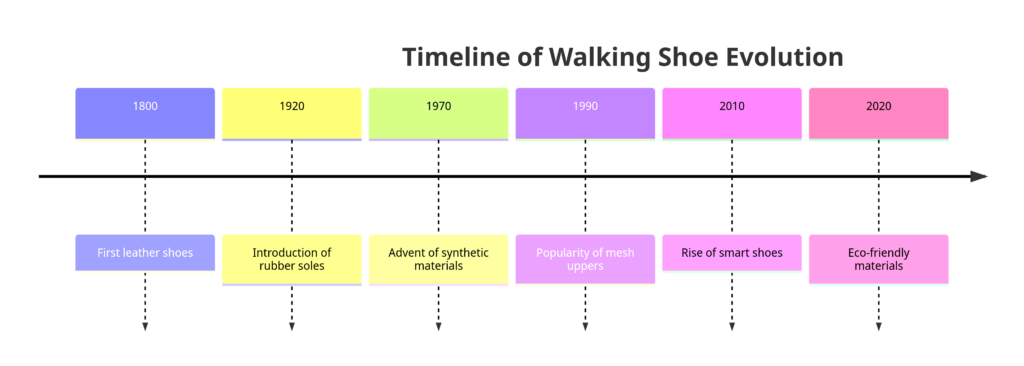
The earliest shoes, dating back thousands of years, were simple leather wraps, fashioned to protect feet from sharp objects and rough terrains. As societies evolved, so did their shoes, reflecting status, occupation, and geography.
However, it was only in the 19th century, with the rise of sports and leisure activities, that the demand for specialized walking shoes began. Initially, they were stiff, heavy, and cumbersome, but as understanding of foot biomechanics grew, shoes became more foot-friendly. Over the decades, with feedback from consumers and advances in shoe crafting, walking shoes evolved into the comfortable, durable, and stylish options we see today.
The role of technology in enhancing walking shoe features.
The leaps and bounds in shoe technology have been nothing short of revolutionary. From the invention of vulcanized rubber, giving birth to the first sneaker, to the use of ethylene-vinyl acetate (EVA), a lightweight foam, the cushioning of shoes transformed drastically. Today, some shoes even boast air or gel-based systems, ensuring maximum comfort.
Advances in material science have led to breathable, waterproof materials, ensuring your feet remain dry regardless of the weather. Not to mention, the use of computer-assisted design (CAD) and 3D printing enables manufacturers to create shoes that are not only comfortable but also tailored to individual foot shapes.
The cultural shift towards health and fitness influencing shoe choices.
There’s no denying the global shift towards health and fitness in recent years. With the rise of health-consciousness, people are walking more, whether it’s for exercise, mindfulness, or a break from the daily grind. This surge in walking has brought with it a demand for shoes that are not just functional but also a style statement.
Brands are responding, creating shoes that cater to various needs – from the avid trekker scaling mountain trails to the urban dweller counting their daily steps. As fashion trends lean into athleisure, walking shoes are not just confined to morning jogs. They’re now flaunted in cafes, offices, and even on fashion runways. It’s evident: as we grow more health-conscious, our footwear choices reflect this cultural evolution.
Why Walk? – Benefits of Walking for Health
Walking is one of the most organic and accessible forms of exercise available to us. With every step, it promises not just physical fitness but also mental rejuvenation and a nod towards a sustainable environment. Let’s dive into these manifold benefits:
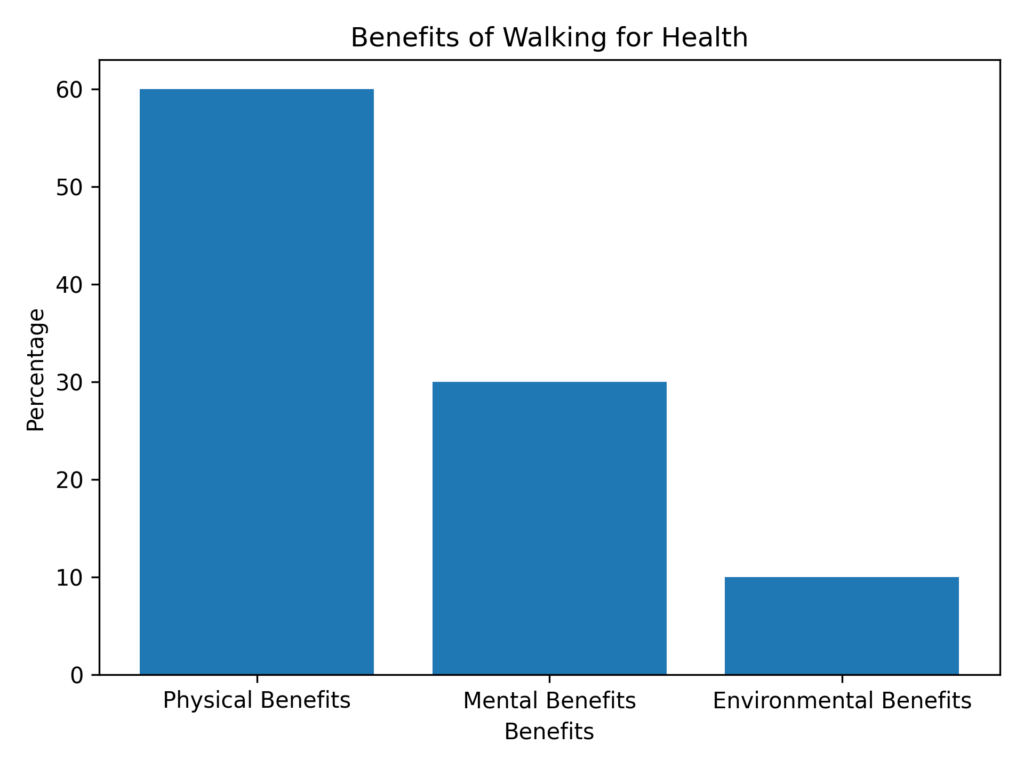
Physical benefits:
Every stride you take, whether brisk or casual, engages a symphony of muscles, bones, and joints, delivering numerous health advantages.
Improved cardiovascular health
- Walking elevates your heart rate, stimulating better blood circulation.
- Regular walks help in fortifying the heart muscles, reducing risks of cardiovascular diseases.
Enhanced muscle tone and strength
- The repetitive motion engages the calf, thigh, and hip muscles, toning them over time.
- Prolonged walking sessions can enhance stamina and overall muscle strength.
Better posture and balance
- Walking encourages maintaining a straight back and lifted chin, fostering good posture.
- Regular walks can fortify the core, providing better balance and coordination.
Mental benefits:
Beyond the evident physical perks, walking offers a sanctuary for the mind, providing clarity, tranquility, and a surge of creativity.
Natural mood enhancers due to endorphin release
- Walking, especially brisk walking, induces the release of endorphins. These are the body’s natural painkillers and mood enhancers.
Cognitive benefits and improved creativity
- A good walk can often clear mental cobwebs, boost focus, and foster new ideas.
- It’s a rejuvenating break that can often lead to ‘Eureka’ moments of creativity.
Meditation and mindfulness through walking
- When you focus on every step, the rhythm of breathing, and the surrounding ambiance, walking becomes a form of meditation.
- Mindful walking can enhance presence, reducing stress and anxiety.
Environmental benefits:
When we choose to walk over other forms of transportation, the environment sighs in relief, thanking us for the reduced carbon emissions.
Reduced carbon footprint
- Opting to walk, especially for shorter distances, directly diminishes carbon emissions associated with vehicle usage.
Encouraging sustainable practices
- A walking culture fosters the development of pedestrian-friendly infrastructure, emphasizing green spaces and sustainable urban designs.
Comparison of Walking with Other Exercises
Walking is a universal activity, something we’ve all engaged in since our very first steps as toddlers. But when it comes to fitness and overall well-being, how does it stack up against other exercises? Let’s compare:

Walking vs. Running:
- Intensity & Impact: While running is a high-intensity exercise, walking is low to moderate. This means that walking is gentler on the joints and is less likely to cause injuries.
- Caloric Burn: Running generally burns more calories per minute compared to walking. However, walking for longer durations can often match the caloric burn of a shorter run.
- Flexibility: Walking can be done anywhere, any time. While the same can be said for running, walking doesn’t require the same level of energy or preparation.
Walking vs. Cycling:
- Muscle Engagement: Cycling predominantly targets the leg muscles, especially the quadriceps. Walking, on the other hand, is a full-body workout, engaging the legs, arms, and core.
- Equipment: Cycling requires a bike and often specific gear. Walking only requires a good pair of shoes.
- Environment: While cycling can cover longer distances and explore varied terrains, walking allows for a more intimate connection with the surroundings, suitable for both urban and nature settings.
Walking vs. Gym Workouts:
- Versatility: Gym workouts can target specific muscle groups and offer varied intensity levels. Walking provides a comprehensive, full-body workout.
- Accessibility: Walking doesn’t require a membership or specific equipment, other than walking shoes. Gym workouts often need access to specialized machines or tools.
- Ambiance: Walking outdoors offers fresh air and ever-changing sceneries, making it mentally refreshing. Gyms provide a controlled environment which can be beneficial for focused training.

Anatomy of a Walking Shoe
Every pair of walking shoes, though may look simple on the exterior, is a marvel of modern design and technology. They’re meticulously crafted with each part having its unique role in providing comfort, support, and durability. To truly understand the genius behind these everyday items, let’s dive deep into their anatomy.

Upper Part: Materials, Design, and Lacing Systems
The upper part of a walking shoe wraps the top of your foot, extending from the toes to the heel, and it’s vital for both style and function.
Materials: Traditionally, leather was the go-to material for this section due to its durability. However, with advancements in textile technology, we now have synthetic materials and meshes that offer breathability, flexibility, and a lightweight feel.
Design: The design is often influenced by the shoe’s purpose (casual vs. athletic) and the current fashion trends. While aesthetics play a role, the design also considers foot protection and ventilation.
Lacing Systems: The traditional lace-up system remains popular, but there are also slip-ons, Velcro straps, and even quick-tightening pulley systems. The right choice ensures a snug fit and reduces chances of blisters or foot strain.
Midsole: Cushioning Materials and Technologies
The midsole is the unsung hero of comfort, lying between the shoe’s upper and outsole.
Cushioning Materials: EVA (ethylene vinyl acetate) is a common material offering lightweight cushioning. For those seeking more resilience, polyurethane is an alternative, though slightly heavier.
Technologies: Brands often boast proprietary cushioning technologies. Whether it’s Nike’s Air units or Adidas’s Boost foam, these innovations aim to enhance comfort, foot protection, and walking efficiency.
Outsole: Grip, Patterns, and Wear Resistance
The shoe’s outsole is its direct point of contact with the ground, making its design crucial for safety and longevity.
Grip: It’s vital for preventing slips and falls. Rubber is a popular choice due to its superior traction properties.
Patterns: The intricate patterns you see on the outsole (often called ‘treads’ or ‘lugs’) aren’t just for aesthetics. They play a pivotal role in providing grip on different terrains.
Wear Resistance: High-quality walking shoes often incorporate carbon rubber in the outsole. This compound is durable and provides a longer lifespan for the shoe, especially in high-wear areas like the heel.
Insole: Comfort, Arch Support, and Moisture-wicking Properties
The insole is the interior bottom of the shoe, and it’s the direct cushion for your foot.
Comfort: Insoles use foam, gel, or a combination of both to ensure foot comfort. Some are even memory foam, molding to your foot’s shape over time.
Arch Support: Not all feet are created equal. Insoles cater to different arch types (low, neutral, high) to provide the necessary support and prevent foot pain.
Moisture-wicking Properties: To prevent sweaty feet and the resulting odor, many insoles have moisture-wicking materials, ensuring your feet remain dry and comfortable.
Critical Factors to Consider When Buying Walking Shoes
Walking shoes aren’t just another fashion statement. They’re an investment in your comfort, health, and overall well-being. Given the myriad of options available today, making the right choice can be overwhelming. Fear not, for we’ve broken down the vital aspects you need to consider when venturing into the shoe market.
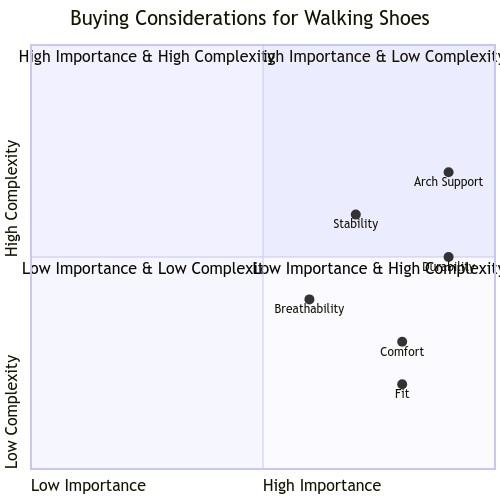
Comfort:
When we talk about shoes, comfort often tops the list, and rightly so. If your shoes aren’t comfortable, no amount of style or durability can compensate.
Insole Cushioning and Memory Foam Advantages:
While basic insole cushioning provides a comfortable base, memory foam takes it a step further. It molds to your foot’s unique shape, offering personalized comfort, reducing pressure points, and ensuring even weight distribution.
Flexibility of the Shoe:
A good walking shoe should move with your foot, not against it. Bend the shoe to ensure it flexes at the ball of the foot, which is the natural flex point. Rigid shoes can lead to foot fatigue and discomfort.
Arch Support:
Your foot’s arch is like its fingerprint – unique and distinct. Recognizing your arch type can significantly influence your shoe-buying decision.
Identifying Foot Arch Type: Low, Neutral, High:
Place your wet foot on a piece of paper. If you see a full imprint, you likely have low arches. A partial imprint indicates a neutral or high arch.
Shoe Designs for Each Arch Type:
- Low Arch (Flat Feet): Look for shoes with motion control or high-stability features.
- Neutral Arch: Shoes with moderate stability are ideal.
- High Arch: Cushioned shoes with a soft midsole absorb shock better.
Stability:
Stability is paramount, especially if you’re prone to foot movement anomalies like pronation and supination.
Heel Counter Importance:
The heel counter is the rigid part at the shoe’s back. A strong heel counter offers better lateral stability and reduces over-pronation or excessive inward roll.
Shoe Designs for Pronation and Supination:
- Pronation: Opt for shoes labeled ‘motion control’ or ‘stability.’
- Supination (Under-pronation): Cushioned shoes with flexibility help.
Breathability:
Breathability can be the dividing line between a comfortable walk and a foot sauna.
Mesh vs. Leather vs. Synthetics:
- Mesh: Offers superior ventilation. Ideal for warm climates.
- Leather: Less breathable but often more durable.
- Synthetics: A middle ground, offering moderate breathability.
Breathability vs. Waterproofing:
It’s a trade-off. While waterproof shoes protect against moisture from the outside, they often offer less ventilation. Choose based on your primary need.
Durability:
Your walking shoes endure a lot, from pounding pavements to navigating trails. Durability ensures you get the most out of your investment.
High-wear Areas to Monitor:
Pay attention to the outsole, especially under the heel and ball of the foot, as these areas tend to wear out faster.
Expected Shoe Lifespan Based on Use:
On average, walking shoes last between 500-1000 miles. However, factors like walking style, terrain, and shoe quality can influence this.
Fit:
A shoe that doesn’t fit right is a recipe for discomfort and potential injuries.
Importance of Trying Shoes in the Evening:
Feet tend to swell during the day. Trying shoes in the evening ensures a fit that’s comfortable throughout the day.
Socks’ Role in Ensuring a Proper Fit:
Always try shoes with the socks you intend to wear. Different sock thicknesses can influence fit.
Exploring Different Types of Walking Shoes
The world of walking shoes is vast and varied, catering to different needs, terrains, and tastes. Whether you’re strolling through the park, hiking rugged trails, or indulging in a brisk walk for fitness, there’s a shoe out there designed with you in mind. Let’s delve into these categories and understand their nuances.

Casual Walking Shoes:
Serving dual purposes of comfort and style, these are the go-to for daily wear, light strolls, or even a day out shopping.
Materials Commonly Used:
- Leather: Offers a refined look and durability but may be less breathable.
- Canvas: Lightweight and breathable, often seen in summer designs.
- Suede: Soft and flexible, it’s a midpoint between formal and sporty.
Style Trends and Popular Brands:
From slip-ons to lace-ups, casual walking shoes come in various styles. Brands like Clarks, Skechers, and Dr. Scholl’s have been at the forefront, offering a mix of elegance and ease.
Trail Walking Shoes:
Built to withstand the challenges of the great outdoors, these shoes are rugged, offering excellent grip and protection.
Features like Toe Guards and Lug Patterns:
- Toe Guards: A reinforced front that protects toes against rocks and rough terrains.
- Lug Patterns: Deep indentations on the sole that ensure grip on uneven surfaces.
Waterproofing Technologies:
With brands like Merrell and Salomon leading the charge, technologies such as GORE-TEX are often incorporated, ensuring feet stay dry amidst puddles and downpours.
Fitness Walking Shoes:
When walking becomes more than just a leisure activity, these shoes come into play, designed to aid performance.
Lightweight Designs and Their Advantages:
A lighter shoe can make all the difference, minimizing foot fatigue, and enabling longer sessions. They often employ breathable meshes and foams that provide both lightness and cushioning.
Role in Speed Walking:
A good fitness walking shoe aids in efficient energy transfer, allowing for quicker steps and better pacing. Brands like New Balance and ASICS offer models specifically tailored for this.
Cross-Training Shoes:
The jack-of-all-trades in the shoe world, these are versatile enough for a gym session, a jog, or even a Zumba class.
Multi-functional Design Aspects:
- Traction: Suitable for both indoor and outdoor activities.
- Cushioning: Adequate for short runs yet firm enough for weight training.
- Lateral Support: For side-to-side movements seen in aerobics or dance workouts.
When and Where to Use Them:
While they’re versatile, cross-trainers might not be the best for specialized activities. They shine in environments like gyms, where varied activities are performed, or for people who dabble in multiple activities without committing to one. Brands like Nike and Adidas have a strong lineup in this category.
Walking Shoes for Specific Needs
Every individual is unique, and so are their requirements when it comes to footwear. As we navigate through life’s different stages and challenges, our shoe needs adapt accordingly. From addressing specific health conditions to catering to age-related requirements, the footwear industry offers solutions tailored to diverse needs.
Health Conditions:
Ensuring one’s health and comfort is paramount. Certain medical conditions demand special attention when selecting the right walking shoe, making it essential to understand their specific needs.
Diabetes and the Need for Non-constricting Shoes:
Diabetic feet can often be more sensitive. It’s crucial to choose shoes that don’t restrict blood flow or pressurize certain foot areas. Soft uppers, wider toe boxes, and seamless designs can make all the difference, ensuring the foot isn’t irritated. Brands like Orthofeet and Propet have a range dedicated to diabetic-friendly designs.
Arthritis and the Role of Cushioning:
Arthritis can make walking a painful task. Shoes with ample cushioning can absorb the impact and offer relief. Memory foam insoles, shock-absorbing midsoles, and adjustable straps for customizable fit are features to look out for. Brands such as Hoka One One and Vionic have been recognized for their arthritis-friendly designs.
Age Considerations:
The feet we’re born with and the ones we grow old with go through a remarkable journey, and the shoes we wear should respect and respond to these changes.
Kids: Growth Considerations and Shoe Flexibility:
Children’s feet are continuously growing and developing. Shoes for them should be flexible, allowing for natural foot movement. Ample toe space is vital to accommodate growth spurts. Breathable materials, easy fastening systems, and durable construction are other aspects to consider. Brands like Stride Rite and Clarks Kids offer designs that prioritize children’s foot health.
Elderly: Slip Resistance and Easy-to-Wear Designs:
For our older generation, stability and safety become paramount. Slip-resistant soles can prevent unfortunate falls, and cushioned collars can offer ankle support. Additionally, designs that are easy to put on, such as slip-ons or Velcro straps, are beneficial. Brands such as Skechers Go Walk series and New Balance have models tailored for senior needs.
Brand Spotlight: Top Brands Overview
Navigating the expansive realm of walking shoes can feel daunting, but certain brands consistently stand out from the rest. Why? They’ve cemented their reputations over time through relentless innovation, responding to customer needs, and, quite simply, delivering quality. In this spotlight, we’ll take a journey into the history, innovations, and the trustworthiness of some of the industry’s most iconic brands.
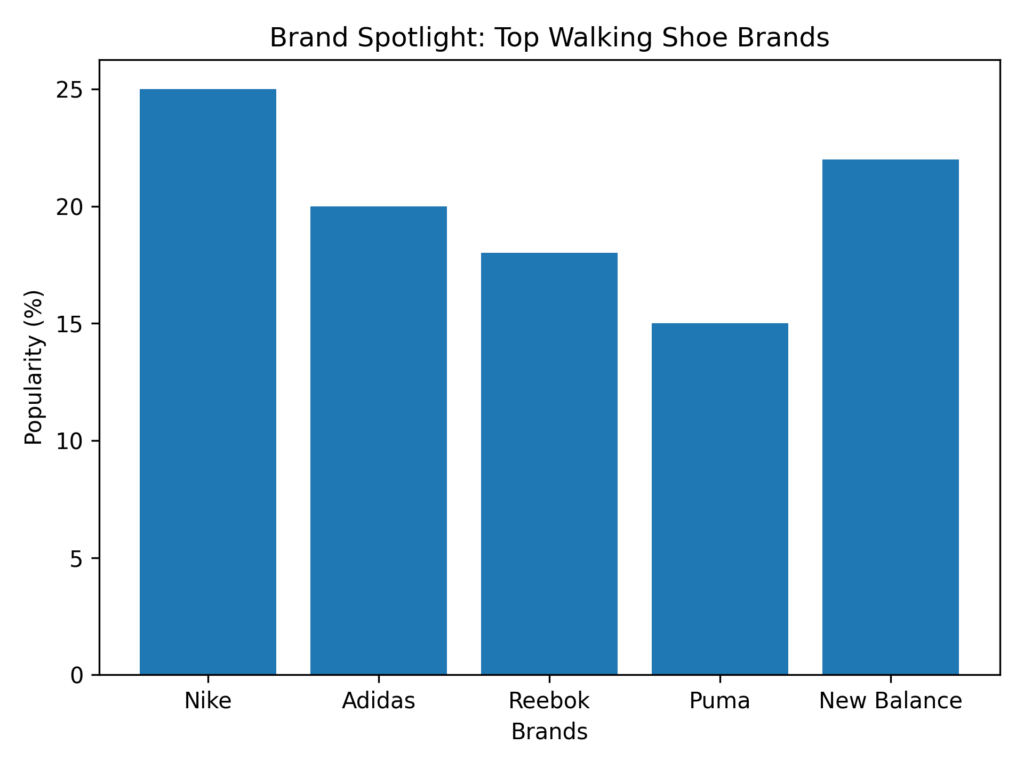
Historical Significance of Brands in the Walking Shoe Industry:
When tracing the lineage of walking shoe brands, certain names have left indelible marks on the sands of time:
New Balance: Founded in 1906, this brand has its roots in arch support designs. Over a century later, they’re synonymous with comfort and have a broad spectrum of shoe offerings.
Brooks: Originating in 1914, Brooks started as a general sports brand. Today, it’s lauded for its commitment to specialized running and walking shoes.
Skechers: A comparatively younger brand, founded in 1992, Skechers swiftly rose to fame, especially with their Go Walk series, revolutionizing the walking shoe industry.
Innovations and Patents Held by Leading Brands:
Brands leading the pack often do so because of their commitment to innovation. Here’s a snapshot of the pioneering steps taken by some:
ASICS: Their GEL technology, introduced in 1986, ushered in a new era of cushioning. The GEL material absorbs shock, making every step softer and more comfortable.
Nike: The introduction of their Air technology in the late ’70s changed the game. This cushioning tech, encapsulated in the sole, provides a unique bounce and protection.
Merrell: Best known for outdoor gear, their QForm Comfort midsole technology is designed keeping in mind the unique stride and anatomy of women’s feet.
Customer Reviews and Trust Factors:
In the digital age, word of mouth has transformed into online reviews. Brands thrive or nosedive based on customer feedback. What sets the best apart?
Adidas: Consistently high ratings across platforms for their Cloudfoam technology shoes showcase their commitment to foot comfort.
Saucony: With their GRID cushioning system, reviews often highlight the brand’s focus on providing stability and cushion in one package.
Hoka One One: Known for oversized midsoles, the brand garners trust for delivering on the promise of unprecedented cushioning without compromising on weight.
Maintenance, Care, and Replacement
Your walking shoes are more than just a piece of footwear; they’re an investment in your health, comfort, and well-being. Like any worthy investment, they deserve attentive care to prolong their lifespan and maintain their functionality. Here, we’ll explore essential aspects of shoe maintenance, from cleaning methods tailored to material types to sustainable disposal approaches.
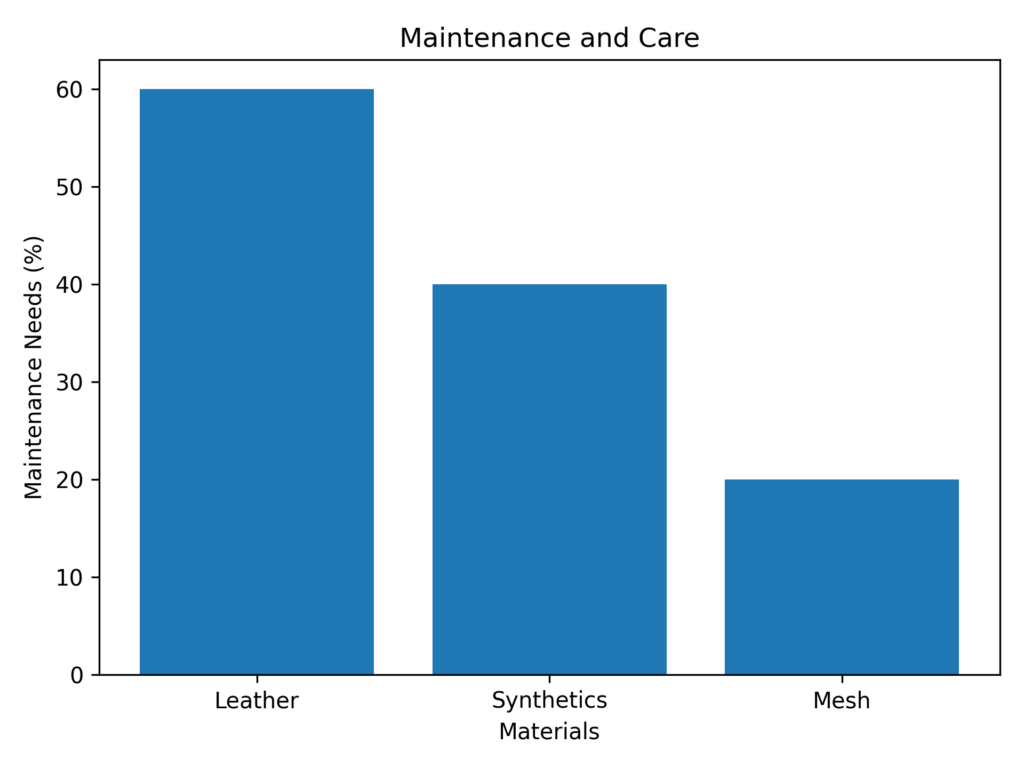
Cleaning Based on Material Type:
Every material has its unique cleaning requirements. Being attentive to these details can ensure your shoes remain in tip-top condition.
Leather: Start with a gentle brush to remove dirt. Use a damp cloth and specialized leather cleaner for a deeper cleanse. It’s essential to let leather shoes air-dry, away from direct heat, to prevent warping or cracking.
Synthetics (like polyester or nylon): Mild soap, warm water, and a soft brush can do wonders. After scrubbing gently, rinse them and let them air-dry. Avoid machine washing as it can degrade the shoe structure.
Mesh: Being delicate, mesh requires a gentle touch. Use cold water, mild soap, and a soft brush. Rinse thoroughly and air-dry, ensuring they’re away from direct sunlight.
Storing Shoes to Maintain Shape:
Proper storage doesn’t just keep shoes organized; it ensures they retain their original shape and remain free from damage.
Use Shoe Trees: Especially beneficial for leather shoes, shoe trees help retain the shoe’s shape, reduce creases, and absorb moisture.
Avoid Stacking: Piling shoes can distort their shape. Instead, line them up side by side or use a shoe organizer.
Store in a Cool, Dry Place: Moisture can be detrimental. Ensure your storage area is dry, and consider using silica packets to absorb excess moisture.
Environmentally Friendly Disposal Methods:
In the age of sustainability, how we dispose of our worn-out shoes matters. Here are eco-friendly methods to consider:
Recycling Programs: Brands like Nike and Adidas offer shoe recycling programs. They transform old footwear into playgrounds, athletic surfaces, and even new shoes.
Donation: If your shoes still have some life left, consider donating them. Organizations like Soles4Souls accept gently worn shoes and distribute them to those in need.
Upcycling: Get creative! Old shoes can be repurposed into plant pots, art projects, or even pet toys.
FAQs
Walking shoes, despite their seemingly straightforward nature, come with a myriad of intricacies. As with any product designed for health and comfort, there are several questions that consumers often ask. In this section, we delve into some of the most common queries, shedding light on topics that can influence your walking experience.
Importance of Rotation Between Multiple Walking Shoes:
Q: Why should I rotate between different pairs of walking shoes?
A: Rotating between shoes serves multiple purposes:
- Longevity: Just like any other footwear, walking shoes need a break. Allowing them to air out and regain their shape can prolong their lifespan.
- Foot Health: Different shoe designs offer varied support and pressure points. Rotation can prevent continuous strain on one part of the foot, reducing the risk of injuries.
- Adaptation: Different activities or terrains might require varied support or grip. Having multiple pairs allows you to choose the best fit for each activity.
Difference Between Unisex and Gender-specific Shoes:
Q: How do unisex walking shoes differ from those designed specifically for men or women?
A: Here’s a simple breakdown:
- Anatomical Differences: Women generally have narrower heels and broader forefoot areas compared to men. Gender-specific shoes cater to these differences.
- Weight: Women’s shoes might be slightly lighter due to the difference in size and materials used.
- Style & Color: While functionality remains paramount, gender-specific shoes might come in colors or designs perceived as more feminine or masculine. On the other hand, unisex shoes aim to offer a neutral design appealing to all.
However, the key is comfort. Always choose shoes based on how they fit and support your feet, regardless of their gender designation.
Using Walking Shoes for Other Activities Like Gym Workouts:
Q: Can I use my walking shoes for gym workouts?
A: While walking shoes are primarily designed for walking, they can be used for some gym activities, but with caveats:
- Treadmill Walking/Running: They’re suitable as the motion is similar to regular walking.
- Weight Lifting: Not ideal. Weightlifting requires flat soles for stability, something walking shoes might not provide.
- Agility Drills: Walking shoes might lack the lateral support needed for side-to-side movements.
In essence, while walking shoes can be versatile, they might not provide the specialized support or protection needed for specific gym activities.
Conclusion
Walking, an activity as ancient as humankind itself, has witnessed significant transformations, especially in the domain of footwear. As we stride into the future, it’s exhilarating to imagine the revolutionary changes the world of walking shoes might see.
Future Trends in Walking Shoe Designs:
The fusion of technology with footwear has already begun, and it promises a plethora of innovations ahead. We’re foreseeing:
- Smart Shoes: Integrated with sensors, these shoes might track your steps, monitor foot health, and even guide your posture.
- Eco-Friendly Materials: As the world moves towards sustainability, expect more shoes made from recycled materials, ensuring you tread lightly on our planet.
- Customized Fit: With 3D printing and AI, we might soon have shoes tailored precisely to the contours of our feet, providing unparalleled comfort.
Encouragement to Personalize Shoe Choices Based on Individual Needs:
Shoes, in many ways, mirror our journey through life. They bear witness to our strides, our races, and sometimes, our stumbles. Therefore, it’s paramount that we choose them wisely.
Remember, while trends offer fresh perspectives, your comfort should never be compromised. Always prioritize shoes that align with your foot’s anatomy, your health requirements, and your walking environment. Whether you’re a casual walker, an avid hiker, or someone with specific foot needs, there’s a perfect pair waiting for you.
In the end, walking shoes are more than just footwear; they’re companions. Choose them well, treat them right, and they’ll ensure every step you take is a comfortable one. So, here’s to many more miles and smiles ahead!